Highland Creek Dental has adopted the Canada Dental Benefit Program and is accepting patients who want to use this Government subsidy…
Highland Creek Dental has adopted the Canada Dental Benefit Program and is accepting patients who want to use this Government subsidy…
An inlay restoration is a custom made filling made of composite material, gold, or tooth-colored porcelain. Porcelain inlays are popular because they resemble your natural tooth. A porcelain inlay is made by a professional dental laboratory and is permanently cemented into the tooth by your dentist.
Inlays can be utilized to conservatively repair teeth that have large defective fillings or have been damaged by decay or trauma. Inlays are an ideal alternative to conventional silver and composite fillings. Also, they are more conservative than crowns because less tooth structure is removed in the preparation of inlays.
As with most dental restorations, inlays are not always permanent and may someday require replacement. They are highly durable and will last many years, giving you a beautiful long lasting smile.
An inlay procedure usually requires two appointments. Your first appointment will include taking several highly accurate impressions (molds) that will be used to create your custom inlay and a temporary restoration.
While the tooth is numb, the dentist will remove any decay and/or old filling materials. The space will then be thoroughly cleaned and carefully prepared, shaping the surface to properly fit an inlay restoration. A temporary filling will be applied to protect the tooth while your inlay is made by a dental laboratory.
At your second appointment your new inlay will be carefully and precisely cemented into place. A few adjustments may be necessary to ensure a proper fit and that your bite is comfortable.
You will receive care instruction at the conclusion of your treatment. Good oral hygiene practices, a proper diet, and regular dental visits will aid in the life of your new inlay.
An onlay restoration is a custom made filling made of composite material, gold, or tooth-colored porcelain. Porcelain onlays are popular because they resemble your natural tooth. An onlay is sometimes also referred to as a partial crown. Porcelain onlays are made by a professional dental laboratory and is permanently cemented onto the tooth by your dentist.
Onlays can be utilized to conservatively repair teeth that have large defective fillings or have been damaged by decay or trauma. Onlays are an ideal alternative to crowns (caps) because less tooth structure is removed in the preparation of onlays. Onlays are essentially identical to inlays with the exception that one or more of the chewing cusps have also been affected and need to be included in the restoration.
As with most dental restorations, onlays are not always permanent and may someday require replacement. They are highly durable and will last many years, giving you a beautiful long lasting smile.
An onlay procedure usually requires two appointments. Your first appointment will include taking several highly accurate impressions (molds) that will be used to create your custom onlay and a temporary restoration.
While the tooth is numb, the dentist will remove any decay and/or old filling materials. The space will then be thoroughly cleaned and carefully prepared, shaping the surface to properly fit an onlay restoration. A temporary filling will be applied to protect the tooth while your onlay is made by a dental laboratory.
At your second appointment, your new onlay will be carefully and precisely cemented into place. A few adjustments may be necessary to ensure a proper fit and that your bite is comfortable.
You will receive care instruction at the conclusion of your treatment. Good oral hygiene practices, a proper diet, and regular dental visits will aid in the life of your new onlay.
Do you suffer from a painful jaw, have difficulty swallowing, or feel a “popping” sensation when you open and close your mouth? These symptoms may be signs you are suffering from Temporomandibular Joint Dysfunction Disorder or TMJ disorder. TMJ disorder is caused by inflammation in the tissues where your lower jawbone joins your skull and can be caused by injury such as whiplash, clenching teeth, arthritis, stress or other causes.
The first step in diagnosing TMJ disorder is to see if your symptoms are being caused by TMJ disorder and not another condition. Diagnosis consists of taking X-Rays of your head and jaw to detect any inflammation or irregularities. We’ll also examine your jaw and jaw motion, and carefully review your dental and medical history.
Treatment for TMJ disorder usually involves anti-inflammatory treatments such as applying heat or cold to the joint. We may also recommend changes to your diet, anti-inflammatory medication, stretches or massage for the joint and surrounding muscles, or relaxation therapy to reduce your level of stress. More serious cases may require physiotherapy or surgery.
If you suffer from a sore jaw or other symptoms of TMJ disorder, contact us to schedule an examination.
In dentistry, intravenous or IV sedation is used to create a conscious sedation or “twilight” state where your body and mind are completely relaxed, but you are not unconscious. IV sedation minimizes any feelings of discomfort or anxiety, while still allowing you to talk, respond to questions and react to verbal cues, while the procedure is occurring.
In most cases, you will have no memory of the procedure and because of the level of relaxation that IV sedation creates, you will need someone to take you home after the procedure is complete. The sedation will begin to wear off once you are out of the office, and you should be able to take part in normal activities within the next day.
One option we offer anxious patients, or patients who need a large number of procedures done during a single visit, sedation dentistry, where we provide an oral sedative that is taken prior to the dental visit. Dr. Sara Razmavar will prescribe you a pill for relaxation purposes, to be taken before your procedure. The effects, which include sleepiness and a general sense of calm, will last several hours, allowing you to get the dental care you need. We do require you to have a driver when opting for oral sedation.
Nitrous oxide sedation transforms adults and children filled with anxieties about dental treatment into comfortable, relaxed and responsive patients.
Also known as “laughing gas”, nitrous oxide is a powerful gas that, when mixed with oxygen and administered via a face masks, blocks pain and reduces anxiety. Commonly used in many aspects of dentistry to keep you more comfortable, combining nitrous oxide with an oral sedative is an excellent way to eliminate feelings of anxiety associated with dental procedures.
Learn more about nitrous oxide.
A composite (tooth colored) filling is used to repair a tooth that is affected by decay, cracks, fractures, etc. The decayed or affected portion of the tooth will be removed and then filled with a composite filling.
There are many types of filling materials available, each with their own advantages and disadvantages. You and your dentist can discuss the best options for restoring your teeth. Composite fillings, along with silver amalgam fillings, are the most widely used today. Because composite fillings are tooth colored, they can be closely matched to the color of existing teeth, and are more aesthetically suited for use in front teeth or more visible areas of the mouth.
As with most dental restorations, composite fillings are not permanent and may someday have to be replaced. They are very durable and will last many years, giving you a long lasting, beautiful smile.
Composite fillings are usually placed in one appointment. While the tooth is numb, your dentist will remove decay as needed. The space will then be thoroughly cleaned and carefully prepared before the new filling is placed. If the decay was near the nerve of the tooth, a special medication will be applied for added protection. The composite filling will then be precisely placed, shaped, and polished, restoring your tooth to its original shape and function.
It is normal to experience sensitivity to hot and cold when composite fillings are first placed, however this will subside shortly after your tooth acclimates to the new filling.
At Highland Creek Dental, you will be given care instructions at the conclusion of your treatment. Good oral hygiene practices, eating habits, and regular dental visits will aid in the life of your new fillings.
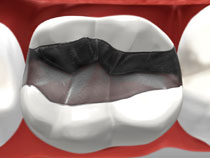

Cosmetic bonding, also called direct or teeth bonding, is a cosmetic and restorative treatment we use at Highland Creek Dental to improve the appearance and/or function of the teeth that show when you smile. A tooth-colored composite resin is applied and then artfully sculpted directly onto the affected tooth or teeth. It is the same biocompatible, natural looking material we use in white fillings.
With cosmetic bonding we can improve the size, shape, color, and alignment of the teeth that show when you smile in just one visit to our comfortable Scarborough dental office. It’s a non-invasive, affordable way to achieve a more beautiful you!
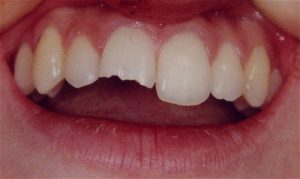
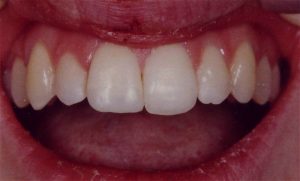
A dental bridge is a fixed (non-removable) appliance and is an excellent way to replace missing teeth
.
There are several types of bridges. You and your dentist will discuss the best options for your particular case. The “traditional bridge” is the most popular type and is usually made of porcelain fused to metal. Porcelain fixed bridges are most popular because they resemble your natural teeth. This type of bridge consists of two crowns that go over two anchoring teeth (abutment teeth) and are attached to pontics (artificial teeth), filling the gap created by one or more missing teeth.
Dental bridges are highly durable and will last many years; however, they may need replacement or need to be re-cemented due to normal wear.
Reasons for a fixed bridge:
Getting a bridge usually requires two or more visits. While the teeth are numb, the two anchoring teeth are prepared by removing a portion of enamel to allow for a crown. Next, a highly accurate impression (mold) is made which will be sent to a dental laboratory where the bridge will be fabricated. In addition, a temporary bridge will be made and worn for several weeks until your next appointment.
At the second visit, your permanent bridge will be carefully checked, adjusted, and cemented to achieve a proper fit. Occasionally your dentist may only temporarily cement the bridge, allowing your teeth and tissue time to get used to the new bridge. The new bridge will be permanently cemented at a later time.
At Highland Creek Dental, you will receive care instructions at the conclusion of your treatment. Proper brushing, flossing and regular dental visits will aid in the life of your new permanent bridge.


A crown (or cap) is a covering that encases the entire tooth surface restoring it to its original shape and size. A crown protects and strengthens tooth structure that cannot be restored with fillings or other types of restorations.
Although there are several types of crowns, porcelain (tooth colored crown) are the most popular, because they resemble your natural teeth. They are highly durable and will last many years, but like most dental restorations, they may eventually need to be replaced. Porcelain crowns are made to match the shape, size, and color or your teeth giving you a natural, long-lasting beautiful smile.
A crown procedure usually requires two appointments. Your first appointment will include taking several highly accurate molds (or impressions) that will be used to create your custom crown. A mold will also be used to create a temporary crown which will stay on your tooth for approximately two weeks until your new crown is fabricated by a dental laboratory.
While the tooth is numb, the dentist will prepare the tooth by removing any decay and shaping the surface to properly fit the crown. Once these details are accomplished, your temporary crown will be placed with temporary cement and your bite will be checked to ensure you are biting properly.
At your second appointment, your temporary crown will be removed, the tooth will be cleaned, and your new crown will be carefully placed to ensure the spacing and bite are accurate. At Highland Creek Dental, you will be given care instructions and encouraged to have regular dental visits to check your new crown.
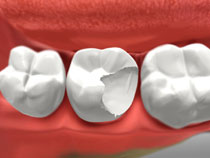
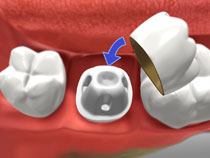
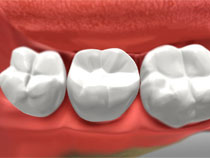
Isn’t it always nice to see a smiling face? It’s even better to see sparkling teeth when the person smiles. Unfortunately, not everyone is blessed with perfect teeth. Stained, cracked, crooked or irregularly shaped teeth can cause undue embarrassment, inhibit social ease, and prevent one from fully enjoying life. If you are one of the many who urgently needs dental restoration, then porcelain veneers might be the right solution for you.
Veneers are ultra-thin, like contact lenses. They are bonded to the surface of the affected tooth in the form of a custom fabrication. Porcelain veneers help to alter tooth position, shape, size and color. If you are looking for a cosmetic lift for your smile, look no further than Highland Creek Dental.
Porcelain veneers, one of the many advancements in the field of cosmetic dentistry, help you achieve the smile you desire in a matter of weeks. Veneers are custom-made, natural-looking porcelain laminates which are specially designed to cover your front teeth. Working to provide patients with some of best veneers at Highland Creek Dental in Scarborough with comprehensive cosmetic care. We recommend veneers under the following conditions:
Because veneers can withstand chipping, staining and daily wear and tear, they have the potential to last the rest of your life, provided you care for your veneers carefully. It’s important to practice daily dental hygiene such as flossing and brushing and to attend regular dental check-ups every six months or so.
In the same way, that bad habits such as biting your nails can hurt your teeth, chewing on improper surfaces can cause damage to your veneers. In general, the veneers will react to circumstances just like regular teeth, so you will need to protect them accordingly.
Veneers are approximately 1 mm thick, whereas a dental crown is usually around 2 mm. A crown will encase the entire tooth, but a veneer simply covers the front area that people see when you smile.
Crowns will be employed when a tooth has decayed or is broken and needs significant restoration. They are ideal for teeth that perform a lot of work, such as those that accomplish chewing, biting, and grinding. When a crown is applied, the tooth will be reduced, and that tooth will always need a crown going forward.
Veneers, on the other hand, are perfect for healthy teeth that simply need cosmetic improvement because of discoloration or an unattractive shape. They work best for the teeth in the front of the mouth that are more responsible for the look of one’s smile than for performing the work of chewing and grinding. With veneers, tooth reduction is not typically required. Like crowns, however, veneers are permanent and cannot be reversed.
Natural teeth are distinguished by the shine of their translucent enamel. The porcelain veneer gives off a similar shine and luster, brightening the smile for a stunning yet organic aesthetic.
At Highland Creek Dental, Dr. Sara and her team of dental experts are some of the best providers of Porcelain veneers Scarborough has to offer. We ensure that the veneers match the color of your existing teeth or a lighter shade you desire. We use porcelain veneers to close gaps between the teeth, correct stains and even make cracks disappear. We promise you results that will exceed your expectations!
You will require more than one appointment to complete the procedure. During the first visit, our dental experts carefully prepare and contour the teeth. We also take an impression of the teeth so as to create the veneers.
During the second visit, the veneer is bonded to the tooth. Once it is done, you can quite easily forget that something was done to your tooth. Your teeth will feel as good as new!
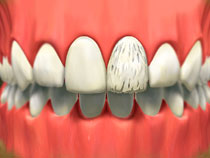
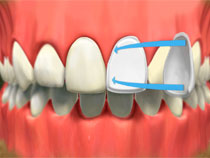
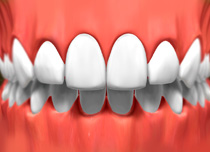
Your Scarborough dentist will make it possible for you to enjoy a drastic transformation to your smile. Here at Highland Creek Dental we believe that everyone deserves a beautiful smile; a smile that they feel confident behind and are not afraid to show. With modern-day technology in dentistry, it is now easier than ever to get the smile of your dreams. Dental procedures such as porcelain veneers can turn your smile into a beautiful, bright and perfectly aligned set of teeth.
Our dental professionals at Highland Creek Dental in Scarborough will examine your natural teeth and go through a planning phase for your new smile, where the shape, size, length, and colour of your teeth, as well as your facial appearance and gum tissue are taken into consideration. Teeth defects, such as chips, cracks, discolouration, crookedness and even gaps between the teeth can all be fixed in your makeover. Dr. Razmavar has extensive training and experience in cosmetic dentistry that she’s able to make even the hardest smile transformations possible.
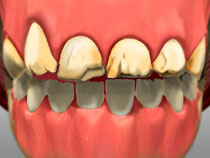
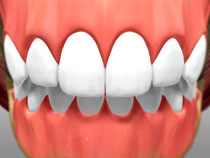
Teeth whitening (or bleaching) is a simple, non-invasive dental treatment used to change the color of natural tooth enamel and is an ideal way to enhance the beauty of your smile.
Because having whiter teeth has now become the number one aesthetic concern of most patients, there are a number of ways to whiten teeth. The most popular method is using a home teeth whitening system that will whiten teeth dramatically. Since teeth whitening only works on natural tooth enamel, it is important to evaluate replacement of any old fillings, crowns, etc. Replacement of any restorations will be done after bleaching so they will match the newly bleached teeth.
Teeth whitening is not permanent. A touch-up may be needed every several years, and more often if you smoke, drink coffee, tea, or wine.
This type of teeth whitening usually requires two visits. At the first appointment, impressions (molds) will be made of your teeth to fabricate custom, clear, plastic, trays.
At your second appointment, you will try on the trays for proper fit, and adjustments will be made if necessary. The trays are worn with special whitening solution either twice a day for 30 minutes or overnight for a couple of weeks depending on the degree of staining and desired level of whitening. It is normal to experience tooth sensitivity during the time you are whitening your teeth, but it will subside shortly after you have stopped bleaching.
At Highland Creek Dental, you will receive care instructions for your teeth and trays, and be encouraged to visit your dentist regularly to help maintain a beautiful, healthy, white smile.
Oral cancer is a result of the abnormal growth of cells in the mouth, tongue, lips and throat. An oral cancer screening is done regularly at Highland Creek dental by our Scarborough dentist or highly skilled dental hygienist. The goal is to detect any signs of cancer as early as possible. The earlier, the easier it is to control and treat it cancer.
The following can increase your risk of oral cancer:
Make sure to book your regular dental hygiene, check-up and oral cancer screening appointment, now!
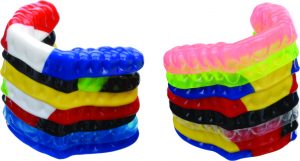
Our teeth are very strong, but they are easily damaged in sports injuries, and they can become worn down if you grind your teeth. Highland Creek Dental offers a variety of custom-made guards to protect against injury and prevent damage from grinding teeth.
Sports guards are custom-made synthetic guards that protect your teeth from being chipped or broken while you are playing sports. Because they are custom-made, they are very comfortable and will not interfere with your game.
Grinding teeth, or bruxism, can occur in your sleep without you even being aware of it. Over time, the grinding will eventually wear away the enamel of your teeth. Custom-made bite appliances fit over your teeth and prevent you from grinding them.
Protect your teeth! Contact us today to discuss how we can provide you with a protective appliance.
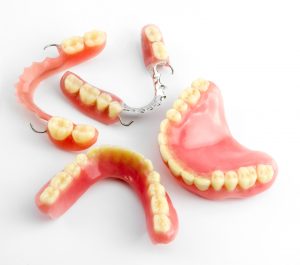 A denture is a removable dental appliance and a replacement for missing teeth and surrounding tissue. They are made to closely resemble your natural teeth and may even enhance your smile.
A denture is a removable dental appliance and a replacement for missing teeth and surrounding tissue. They are made to closely resemble your natural teeth and may even enhance your smile.
There are two types of dentures – complete and partial dentures. Complete dentures are used when all of the teeth are missing, while partial dentures are used when some natural teeth remain. A partial denture not only fills in the spaces created by missing teeth, it prevents other teeth from shifting.
A complete denture can be either “conventional” or “immediate.” A conventional type is made after the teeth have been removed and the gum tissue has healed (usually takes 4 to 6 weeks). During this time, the patient will go without teeth. Immediate dentures are made in advance and immediately placed after the teeth are removed, thus preventing the patient from having to be without teeth during the healing process. Once the tissues shrink and heal, adjustments will have to be made.
Dentures are very durable appliances and will last many years but may have to be remade, repaired, or readjusted due to normal wear.
The process of getting dentures requires several appointments, usually over a period of several weeks. Highly accurate impressions (molds) and measurements are taken and used to create your custom denture. Several “try-in” appointments may be necessary to ensure proper shape, color, and fit. At the final appointment, your dentist will precisely adjust and place the completed denture, ensuring a natural and comfortable fit.
It is normal to experience increased saliva flow, some soreness, and possible speech and chewing difficulty, however this will subside as your muscles and tissues get used to the new dentures.
At Highland Creek Dental you will be given care instructions for your new dentures. Proper cleaning of your new dental appliance, good oral hygiene, and regular dental visits will aid in the life of your new dentures.
Third molars, commonly referred to as wisdom teeth, are usually the last four of 32 teeth to erupt (surface) in the mouth, generally making their appearance between the ages of 17 to 25. They are located at the back of the mouth (top and bottom), near the entrance to the throat. The term “wisdom” stems from the idea that the molars surface at a time typically associated with increased maturity or “wisdom”.
In most cases, inadequate space in the mouth does not allow the wisdom teeth to erupt properly and become fully functional. When this happens, the tooth can become impacted (stuck) in an undesirable or potentially harmful position. If left untreated, impacted wisdom teeth can contribute to infection, damage to other teeth, and possibly cysts or tumors.
There are several types, or degrees, of impaction based on the actual depth of the teeth within the jaw:
Soft Tissue Impaction: The upper portion of the tooth (the crown) has penetrated through the bone, but the gingiva (gum) is covering part or all of the tooth’s crown and has not positioned properly around the tooth. Because it is difficult to keep the area clean, food can become trapped below the gum and cause an infection and/or tooth decay, resulting in pain and swelling.
Partial Bony Impaction: The tooth has partially erupted, but a portion of the crown remains submerged below the gum and surrounding jawbone. Again, because it is difficult to keep the area clean, infection will commonly occur.
While not all wisdom teeth require removal, wisdom teeth extractions are most often performed because of an active problem such as pain, swelling, decay or infection, or as a preventative measure to avoid serious problems in the future. If impaction of one or more wisdom teeth is present, and left untreated, a number of potentially harmful outcomes can occur, including:
As with any dental procedure, your dentist will want to initially conduct a thorough examination of the wisdom and surrounding teeth. At Highland Creek Dental, Panoramic or digital X-rays will be taken in order for your dentist to evaluate the position of the wisdom teeth and determine if a current problem exists, or the likelihood of any potential future problems. The X-rays can also expose additional risk factors, such as deterioration or decay of nearby teeth. Early evaluation and treatment (typically in the mid-teen years) is recommended in order to identify potential problems and to improve the results for patients requiring wisdom teeth extractions. Only after a thorough examination can your dentist provide you with the best options for your particular case.
Wisdom teeth removal is a common procedure, generally performed under local anesthesia, intravenous (IV) sedation, or general anesthesia by a specially trained dentist at our Scarborough location. The surgery does not require an overnight stay, and you will be released with post-operative instructions and medication (if necessary), to help manage any swelling or discomfort.
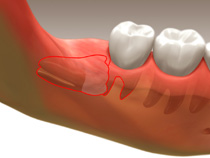
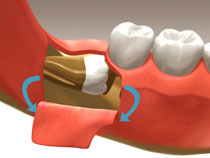
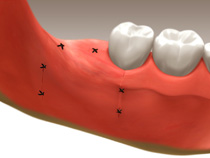
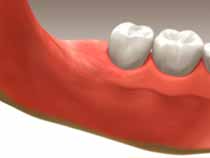
A sealant is a thin, plastic coating applied to the chewing surface of molars, premolars and any deep grooves (called pits and fissures) of teeth. More than 75% of dental decay begins in these deep grooves. Teeth with these conditions are hard to clean and are very susceptible to decay. A sealant protects the
tooth by sealing deep grooves, creating a smooth, easy to clean surface.
Sealants can protect teeth from decay for many years, but need to be checked for wear and chipping at regular dental visits.
Sealants are easily applied by your dentist or dental hygienist at Highland Creek ental and the process takes only a couple of minutes per tooth.
The teeth to be sealed are thoroughly cleaned and then surrounded with cotton to keep the area dry. A special solution is applied to the enamel surface to help the sealant bond to the teeth. The teeth are then rinsed and dried. Sealant material is carefully painted onto the enamel surface to cover the deep grooves or depressions. Depending on the type of sealant used, the material will either harden automatically or with a special curing light.
Proper home care, a balanced diet, and regular dental visits will aid in the life of your new sealants.
At Highland Creek Dental we love kids, and it shows! We try to provide a friendly (and fun!) environment for our youngest patients, and we are committed to helping kids learn about and maintain good dental health. When you come into our office in Scarborough, your kids will be greeted with a smile and we’ll do everything we can to make sure they leave with one.
Good dental health for kids begins at birth. Your baby’s teeth are already growing when they are born, and it’s important to check their jaw and mouths to ensure that their jaws are developing normally and their baby teeth are emerging correctly. When they begin teething, we can help you feel sure that their teeth are healthy and growing in well. Regular visits to the dentist at a very young age also help young children get comfortable with having their teeth and mouths examined.
When their baby teeth grow in, kids need to learn about dental health. We teach them how to brush and floss and how to care for their teeth, as well as the importance of a good diet. This is also the time to begin regular cleanings and fluoride treatments.
Later, when their adult teeth begin to grow in, we’ll assess the growth of these important teeth to check their alignment to identify any issues that may require orthodontic treatment.
If you are looking for a friendly family dentist who loves kids, look no further! Contact us for an appointment today.
Root canal therapy is needed when the nerve of a tooth is affected by decay or infection. In order to save the tooth, the pulp (the living tissue inside the tooth), nerves, bacteria, and any decay are removed and the resulting space is filled with special, medicated, dental materials, which restore the tooth to its full function.
Having a root canal done on a tooth is the treatment of choice to save a tooth that otherwise would die and have to be removed. Many patients believe that removing a tooth that has problems is the solution, but what is not realized is that extracting (pulling) a tooth will ultimately be more costly and cause significant problems for adjacent teeth.
Root canal treatment is highly successful and usually lasts a lifetime, although on occasion, a tooth will have to be retreated due to new infections.
Root canal treatment is highly successful and usually lasts a lifetime, although on occasion, a tooth will have to be retreated due to new infections.
A root canal procedure requires one or more appointments and can be performed by a dentist or endodontist (a root canal specialist).
While the tooth is numb, a rubber dam (a sheet of rubber) will be placed around the tooth to keep it dry and free of saliva. An access opening is made on top of the tooth and a series of root canal files are placed into the opening, one at a time, removing the pulp, nerve tissue, and bacteria. If tooth decay is present, it will also be removed with special dental instruments.
Once the tooth is thoroughly cleaned, it will be sealed with either a permanent filling or, if additional appointments are needed, a temporary filling will be placed.
At the next appointment, usually a week later, the roots and the inside cavity of the tooth will be filled and sealed with special dental materials. A filling will be placed to cover the opening on top of the tooth. In addition, all teeth that have root canal treatment should have a crown (cap) placed. This will protect the tooth and prevent it from breaking, and restore it to its full function.
After treatment, your tooth may still be sensitive, but this will subside as the inflammation diminishes and the tooth has healed.
Your dentist at Highland Creek Dental will be given care instructions after each appointment. Good oral hygiene practices and regular dental visits will aid in the life of your root canal treatment.
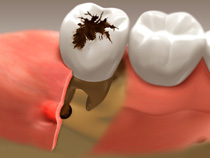

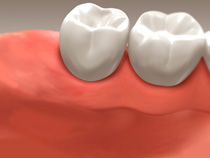
Like many other ailments gum disease can be quite painless due to its slow progression. After a thorough periodontal screening and examination we may choose more aggressive therapies aimed at eliminating or reducing the amounts of bacterial poisons and plaque accumulating below the gum line (generally cleaning and polishing of teeth is above the gum-line). This involves curettage and root-planning and/or treatment with site specific administration of medications to the affected gums.
Curettage is the debridement of the soft tissue lining around the tooth. In disease this tissue is chronically irritated by bacteria deep below the visible gum-line and needs to be removed so that proper healing can occur.
Root-Planning is the removal and smoothing of micro-amounts of root surface so that a clean and un-infected surface is presented to the healing lining of soft tissue.
These two procedures are generally done simultaneously. They may require local anesthesia and are skillfully done by our well trained hygienists under Highland Creek Dental’s prescription. Our hygiene team will work with you to assure that you have access to the care that best suits your needs. They will also help you hone your home-care skills so that you can maintain the optimum level of health that you want.
A comprehensive dental exam will be performed by your dentist at your initial dental visit. At regular check-up exams, your dentist and hygienist will perform the following:
Professional dental cleanings (Oral Hygiene) are usually performed by Registered Dental Hygienists at Highland Creek Dental. Your cleaning appointment will include a dental exam and the following:
